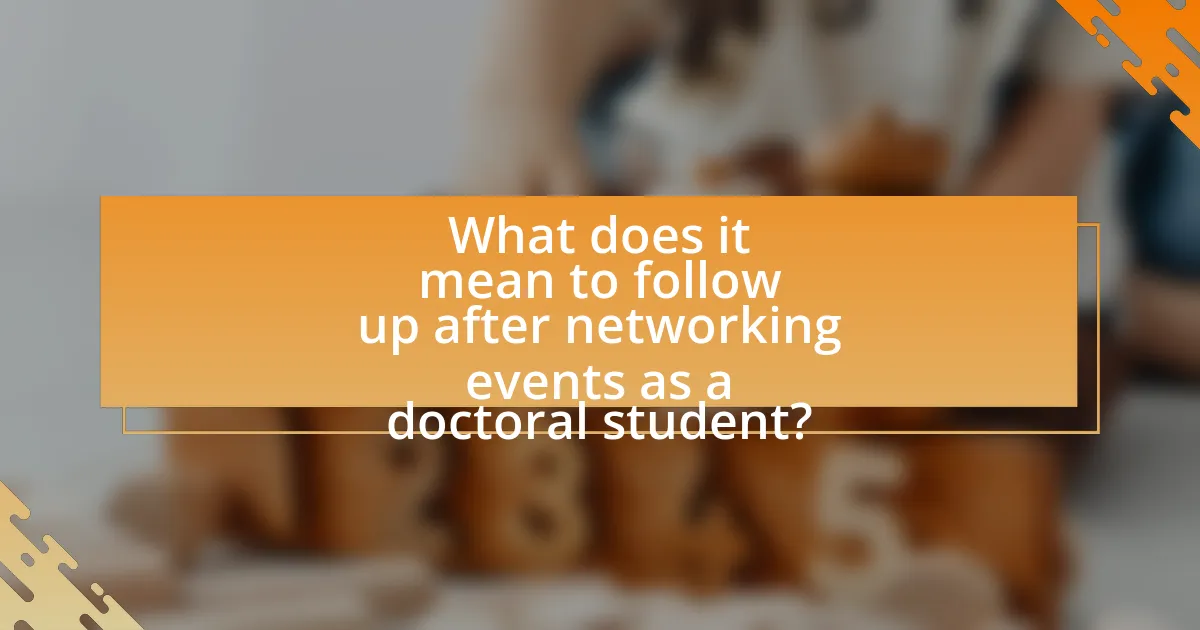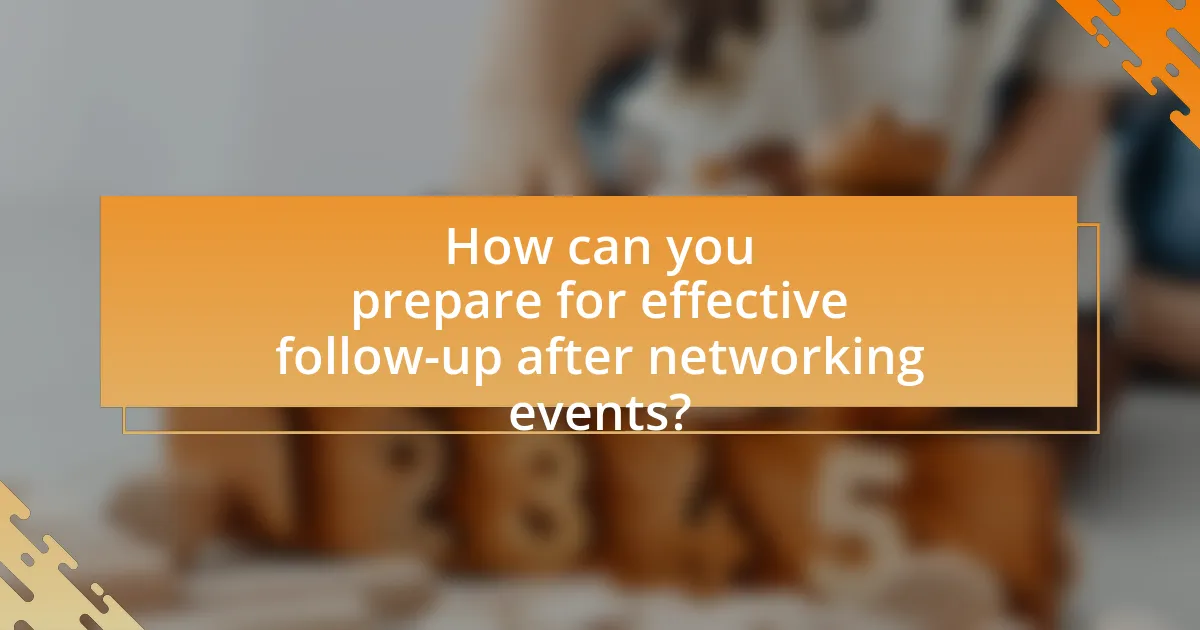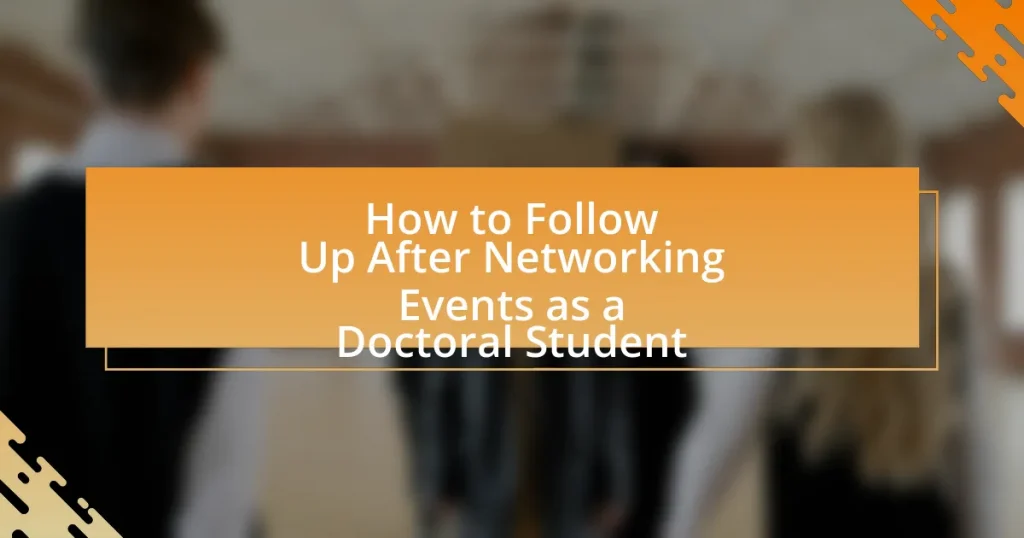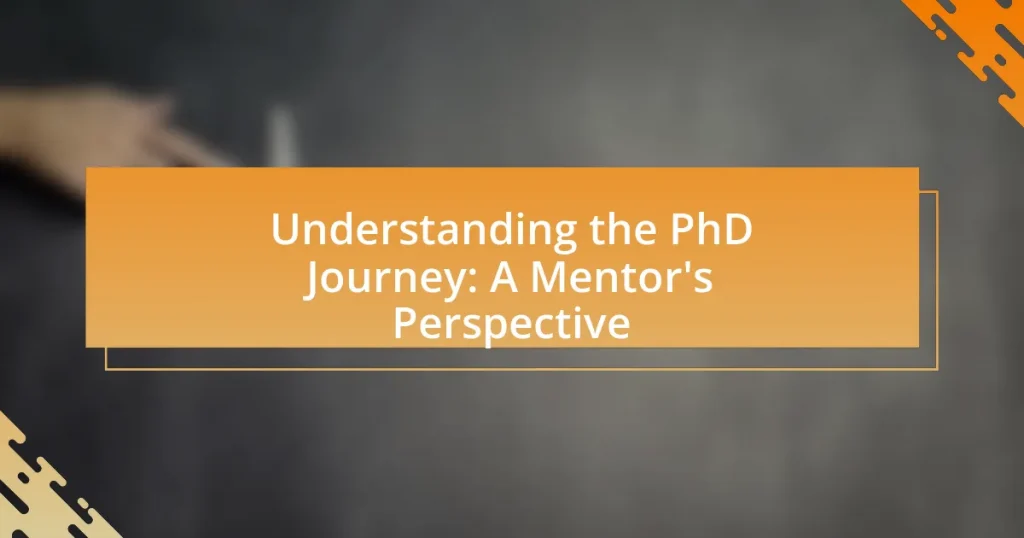The article focuses on the importance of following up after networking events for doctoral students, emphasizing how this practice can strengthen professional relationships and enhance career opportunities. It outlines effective methods for follow-up, including personalized emails and social media engagement, and highlights the benefits of timely communication in establishing lasting connections. Key strategies for organizing contacts, crafting personalized messages, and maintaining consistent outreach are discussed, along with common pitfalls to avoid. Overall, the article serves as a comprehensive guide for doctoral students seeking to maximize their networking efforts through effective follow-up techniques.

What does it mean to follow up after networking events as a doctoral student?
Following up after networking events as a doctoral student means reaching out to the contacts made during the event to reinforce connections and explore potential collaborations or opportunities. This process typically involves sending personalized emails or messages that reference specific conversations or shared interests, thereby demonstrating genuine engagement. Research indicates that effective follow-up can significantly enhance networking outcomes; for instance, a study published in the Journal of Business and Technical Communication found that timely follow-ups increase the likelihood of establishing lasting professional relationships.
Why is following up important for doctoral students?
Following up is important for doctoral students because it helps to solidify professional relationships and enhances networking opportunities. By reaching out after networking events, doctoral students can reinforce their presence in the minds of potential collaborators, mentors, or employers, which is crucial in academia where connections often lead to research opportunities and career advancements. Research indicates that effective networking can significantly impact career trajectories, with studies showing that 70% of jobs are found through networking. Therefore, timely follow-ups can lead to increased visibility and potential collaborations, ultimately benefiting a doctoral student’s academic and professional journey.
What are the potential benefits of effective follow-up?
Effective follow-up can significantly enhance professional relationships and opportunities. By maintaining communication after networking events, individuals can reinforce connections, leading to potential collaborations, mentorships, or job opportunities. Research indicates that 80% of sales require five follow-ups after the initial contact, highlighting the importance of persistence in building relationships. Additionally, effective follow-up can increase the likelihood of receiving referrals, as 70% of people prefer to work with those they know and trust. Thus, the benefits of effective follow-up include strengthened relationships, increased opportunities, and enhanced trust within professional networks.
How can follow-up enhance professional relationships?
Follow-up enhances professional relationships by demonstrating commitment and interest in ongoing communication. When individuals follow up after initial interactions, they reinforce connections, show appreciation, and provide opportunities for further dialogue. Research indicates that consistent follow-up can lead to stronger networking outcomes, as it keeps the relationship active and relevant. For instance, a study published in the Journal of Business and Psychology found that maintaining contact through follow-ups significantly increases the likelihood of collaboration and support in professional settings.
What are the common methods for following up?
Common methods for following up after networking events include sending personalized emails, connecting on professional social media platforms like LinkedIn, and scheduling follow-up meetings or calls. Personalized emails allow for direct communication, reinforcing the connection made during the event. Connecting on LinkedIn helps maintain the relationship and provides a platform for sharing relevant content. Scheduling follow-up meetings or calls facilitates deeper discussions and potential collaborations. These methods are effective as they foster ongoing engagement and demonstrate professionalism in networking.
How can email be used effectively for follow-up?
Email can be used effectively for follow-up by being concise, personalized, and timely. A concise email respects the recipient’s time, while personalization demonstrates genuine interest and connection. Timeliness ensures that the follow-up is relevant and reinforces the initial interaction. Research indicates that follow-up emails sent within 24 to 48 hours of an event have a higher response rate, as they capitalize on the recipient’s recent memory of the interaction.
What role do social media platforms play in follow-up?
Social media platforms serve as essential tools for follow-up after networking events, enabling doctoral students to maintain connections and engage with peers and professionals. These platforms facilitate direct communication, allowing users to send messages, share updates, and comment on posts, which fosters ongoing relationships. For instance, a study by Pew Research Center indicates that 69% of adults in the U.S. use social media, highlighting its prevalence as a communication medium. This widespread usage underscores the effectiveness of social media in reaching out to contacts made during networking events, thereby enhancing professional visibility and collaboration opportunities.
What should be included in a follow-up message?
A follow-up message should include a personalized greeting, a reference to the previous interaction, a specific mention of any shared interests or topics discussed, and a clear call to action. Personalization demonstrates attentiveness, while referencing the prior conversation reinforces the connection. Mentioning shared interests helps to strengthen the relationship, and a call to action encourages further engagement, such as scheduling a meeting or continuing the discussion. This structure is effective in maintaining professional relationships and fostering collaboration, as supported by networking best practices that emphasize the importance of follow-up in building lasting connections.
How can you personalize your follow-up communication?
To personalize your follow-up communication, reference specific details from your previous interaction with the individual. This can include mentioning a topic you discussed, a shared interest, or a particular insight they provided. Personalization enhances engagement and demonstrates genuine interest, which is supported by research indicating that tailored communication increases response rates by up to 50%. By incorporating these elements, you create a more meaningful connection that encourages further dialogue.
What key points should you address in your message?
In your message, you should address the purpose of your follow-up, express gratitude, and reference specific interactions. Clearly state your intent, such as seeking advice or collaboration, to provide context for your outreach. Expressing gratitude reinforces positive rapport, while referencing specific interactions demonstrates attentiveness and personalizes the communication. For example, mentioning a particular discussion point can strengthen the connection and make your message more memorable.

How can you prepare for effective follow-up after networking events?
To prepare for effective follow-up after networking events, a doctoral student should organize contact information and notes immediately after the event. This organization allows for timely and personalized follow-ups, which are crucial for maintaining connections. Research indicates that 70% of networking success comes from timely follow-up, emphasizing the importance of acting quickly. Additionally, crafting tailored messages that reference specific conversations or shared interests can significantly enhance engagement, as personalized communication has been shown to increase response rates by up to 50%.
What steps should you take immediately after the event?
Immediately after the event, you should send personalized thank-you emails to the individuals you connected with. This action reinforces your interest and appreciation for their time, which can strengthen your professional relationships. Research indicates that timely follow-up communications can significantly enhance networking outcomes, as noted in studies on professional networking effectiveness.
How can you organize the contacts you made?
To organize the contacts you made, create a digital database or spreadsheet that includes essential information such as names, email addresses, phone numbers, and notes on your interactions. This method allows for easy sorting and searching, facilitating efficient follow-up communication. Research indicates that maintaining organized contact lists enhances networking effectiveness, as it enables timely outreach and relationship management.
What information should you gather for future reference?
You should gather contact information, including names, email addresses, and phone numbers of individuals you meet at networking events. This information is essential for future communication and collaboration opportunities. Additionally, note the context of your conversations, such as shared interests or specific topics discussed, to personalize follow-up messages. Collecting this information enhances your networking effectiveness and fosters meaningful professional relationships.
How can you create a follow-up schedule?
To create a follow-up schedule, first identify the individuals you want to follow up with after a networking event. Next, categorize these individuals based on the level of connection and the urgency of follow-up, such as immediate, within a week, or longer-term. Then, set specific dates and times for each follow-up, ensuring that you allocate time for personalized messages or emails. Utilize tools like calendars or task management apps to remind you of these follow-up dates. Research indicates that timely follow-ups can significantly enhance networking effectiveness, with studies showing that 80% of successful networking outcomes stem from consistent follow-up efforts.
What factors should influence your timing for follow-up?
The timing for follow-up should be influenced by the context of the networking event, the relationship established, and the urgency of the matter discussed. Context includes the nature of the event; for instance, follow-ups should occur sooner after a conference than after a casual meeting. The relationship established during the interaction also plays a crucial role; stronger connections warrant quicker follow-ups, ideally within 24 to 48 hours. Additionally, if specific actions or commitments were discussed, such as sending information or scheduling a meeting, the urgency of these matters should dictate a prompt follow-up to maintain momentum and demonstrate professionalism.
How often should you reach out to your contacts?
You should reach out to your contacts every 4 to 6 weeks. This frequency allows you to maintain a connection without overwhelming them, ensuring that your interactions remain meaningful and relevant. Research indicates that consistent communication fosters stronger professional relationships, as noted in studies on networking effectiveness, which emphasize the importance of regular engagement for relationship building.

What are some best practices for following up after networking events?
Best practices for following up after networking events include sending personalized thank-you emails within 24 to 48 hours, referencing specific conversations to reinforce connections. This approach demonstrates attentiveness and helps recipients remember the interaction. Additionally, connecting on professional platforms like LinkedIn can enhance visibility and facilitate ongoing communication. Research indicates that timely follow-ups can increase the likelihood of establishing lasting professional relationships, as noted in a study by the Harvard Business Review, which found that prompt communication significantly improves networking outcomes.
How can you ensure your follow-up is effective?
To ensure your follow-up is effective, personalize your communication by referencing specific details from your previous interaction. Personalization increases engagement; studies show that tailored messages can improve response rates by up to 50%. Additionally, set a clear purpose for your follow-up, whether it’s to express gratitude, share relevant resources, or propose a meeting. This clarity helps the recipient understand your intent and encourages a timely response. Finally, follow up within a week of the initial interaction, as timely communication is crucial; research indicates that follow-ups sent within this timeframe are more likely to be remembered and acted upon.
What tone and language should you use in your messages?
Use a professional and courteous tone in your messages. This tone fosters respect and establishes credibility, which is essential in academic and professional networking. Language should be clear, concise, and free of jargon to ensure effective communication. Research indicates that messages with a polite and respectful tone are more likely to receive positive responses, as they create a welcoming atmosphere for dialogue.
How can you make your follow-up stand out?
To make your follow-up stand out, personalize your message by referencing specific details from your conversation with the individual. Personalization demonstrates attentiveness and reinforces your connection, making it more memorable. For instance, mentioning a shared interest or a particular topic discussed can enhance engagement. Research indicates that personalized communication increases response rates by up to 29%, highlighting its effectiveness in networking contexts.
What common mistakes should you avoid in follow-up?
Common mistakes to avoid in follow-up include being too aggressive, failing to personalize messages, and neglecting to provide value. Being overly persistent can alienate contacts; research indicates that 70% of professionals prefer a balanced approach to follow-ups. Personalizing messages is crucial, as generic communications can lead to a 50% lower response rate. Additionally, failing to offer value, such as sharing relevant resources or insights, diminishes the effectiveness of follow-ups, as 65% of networking success relies on mutual benefit.
How can over-communication negatively impact your networking?
Over-communication can negatively impact networking by overwhelming contacts and diluting the effectiveness of messages. When individuals send excessive messages, it can lead to frustration and disengagement from the recipient, as they may feel bombarded and unable to prioritize their responses. Research indicates that communication overload can result in decreased productivity and increased stress, which can hinder relationship-building efforts. For instance, a study published in the Journal of Business Communication found that 70% of professionals reported feeling overwhelmed by the volume of emails and messages they receive, leading to a decline in meaningful interactions. This suggests that maintaining a balance in communication is crucial for fostering strong networking relationships.
What are the risks of being too informal in your follow-up?
Being too informal in your follow-up can damage your professional reputation and undermine the seriousness of your intentions. Informal communication may lead recipients to perceive you as unprofessional or lacking respect for the relationship, which can hinder future networking opportunities. Research indicates that first impressions are crucial; a study published in the Journal of Personality and Social Psychology found that people form judgments about others within seconds, often based on communication style. Therefore, maintaining a professional tone in follow-ups is essential for establishing credibility and fostering meaningful connections in academic and professional settings.
What practical tips can enhance your follow-up strategy?
To enhance your follow-up strategy after networking events, prioritize timely communication by reaching out within 24 to 48 hours post-event. This timeframe increases the likelihood of your message being remembered and appreciated. Additionally, personalize your follow-up messages by referencing specific conversations or shared interests, which fosters a stronger connection. Research indicates that personalized communication can improve response rates by up to 29%. Lastly, utilize multiple channels, such as email and social media, to ensure your message reaches the recipient effectively, as diverse touchpoints can enhance engagement.
How can you leverage templates for efficiency?
You can leverage templates for efficiency by creating standardized follow-up messages that streamline communication after networking events. These templates save time and ensure consistency in your outreach, allowing you to quickly personalize messages while maintaining a professional tone. Research indicates that using templates can reduce the time spent on repetitive tasks by up to 30%, enabling you to focus on building relationships rather than drafting individual messages.
What tools can assist in managing your follow-up process?
Tools that can assist in managing your follow-up process include customer relationship management (CRM) software, email tracking tools, and task management applications. CRM software like HubSpot or Salesforce helps organize contacts and track interactions, ensuring timely follow-ups. Email tracking tools such as Yesware or Boomerang notify users when emails are opened, allowing for strategic follow-up timing. Task management applications like Trello or Asana facilitate the scheduling and prioritization of follow-up tasks, enhancing overall efficiency. These tools collectively streamline the follow-up process, making it easier to maintain connections established during networking events.



